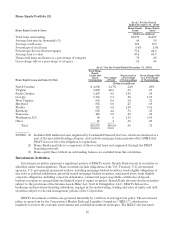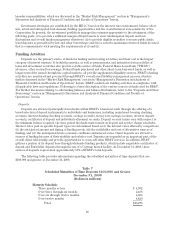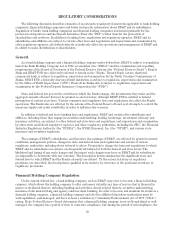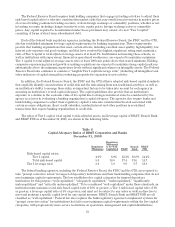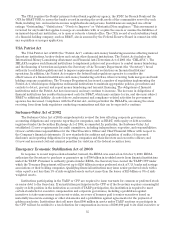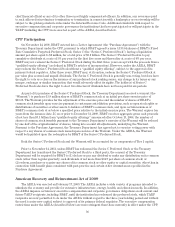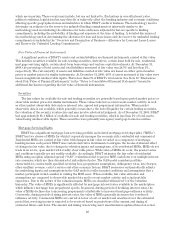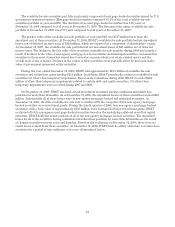BB&T 2008 Annual Report Download - page 35
Download and view the complete annual report
Please find page 35 of the 2008 BB&T annual report below. You can navigate through the pages in the report by either clicking on the pages listed below, or by using the keyword search tool below to find specific information within the annual report.The CRA requires the Banks’ primary federal bank regulatory agency, the FDIC for Branch Bank and the
OTS for BB&T FSB, to assess the bank’s record in meeting the credit needs of the communities served by each
Bank, including low- and moderate-income neighborhoods and persons. Institutions are assigned one of four
ratings: “Outstanding,” “Satisfactory,” “Needs to Improve” or “Substantial Noncompliance.” This assessment is
reviewed for any bank that applies to merge or consolidate with or acquire the assets or assume the liabilities of
an insured depository institution, or to open or relocate a branch office. The CRA record of each subsidiary bank
of a financial holding company, such as BB&T, also is assessed by the Federal Reserve Board in connection with
any acquisition or merger application.
USA Patriot Act
The USA Patriot Act of 2001 (the “Patriot Act”) contains anti-money laundering measures affecting insured
depository institutions, broker-dealers and certain other financial institutions. The Patriot Act includes the
International Money Laundering Abatement and Financial Anti-Terrorism Act of 2001 (the “IMLAFA”). The
IMLAFA requires such financial institutions to implement policies and procedures to combat money laundering
and the financing of terrorism and grants the Secretary of the Treasury Department (the “Secretary”) broad
authority to establish regulations and to impose requirements and restrictions on financial institutions’
operations. In addition, the Patriot Act requires the federal bank regulatory agencies to consider the
effectiveness of a financial institution’s anti-money laundering activities when reviewing bank mergers and bank
holding company acquisitions. The Treasury Department has issued a number of regulations implementing the
Patriot Act, which impose obligations on financial institutions to maintain appropriate policies, procedures and
controls to detect, prevent and report money laundering and terrorist financing. The obligations of financial
institutions under the Patriot Act have increased, and may continue to increase. The increase in obligations of
financial institutions has resulted in increased costs for BB&T, which may continue to rise, and also may subject
BB&T to additional liability. As noted above, enforcement and compliance-related activities by government
agencies has increased. Compliance with the Patriot Act, and in particular the IMLAFA, are among the areas
receiving focus from bank regulators conducting examinations and this can be expected to continue.
Sarbanes-Oxley Act of 2002
The Sarbanes-Oxley Act of 2002 comprehensively revised the laws affecting corporate governance,
accounting obligations and corporate reporting for companies, such as BB&T, with equity or debt securities
registered under the Securities Exchange Act of 1934, as amended. In particular, the Sarbanes-Oxley Act
established: (1) new requirements for audit committees, including independence, expertise, and responsibilities;
(2) new certification responsibilities for the Chief Executive Officer and Chief Financial Officer with respect to
the Company’s financial statements; (3) new standards for auditors and regulation of audits; (4) increased
disclosure and reporting obligations for reporting companies and their directors and executive officers; and
(5) new and increased civil and criminal penalties for violation of the federal securities laws.
Emergency Economic Stabilization Act of 2008
In response to recent unprecedented market turmoil, the EESA was enacted on October 3, 2008. EESA
authorizes the Secretary to purchase or guarantee up to $700 billion in troubled assets from financial institutions
under the TARP. Pursuant to authority granted under EESA, the Secretary has created the TARP CPP under
which the Treasury Department will invest up to $250 billion in senior preferred stock of U.S. banks and savings
associations or their holding companies. Qualifying financial institutions may issue senior preferred stock with a
value equal to not less than 1% of risk-weighted assets and not more than the lesser of $25 billion or 3% of risk-
weighted assets.
Institutions participating in the TARP or CPP are required to issue warrants for common or preferred stock
or senior debt to the Secretary. If an institution participates in the CPP or if the Secretary acquires a meaningful
equity or debt position in the institution as a result of TARP participation, the institution is required to meet
certain standards for executive compensation and corporate governance, including a prohibition against
incentives to take unnecessary and excessive risks, recovery of bonuses paid to senior executives based on
materially inaccurate earnings or other statements and a prohibition against agreements for the payment of
golden parachutes. Institutions that sell more than $300 million in assets under TARP auctions or participate in
the CPP will not be entitled to a tax deduction for compensation in excess of $500,000 paid to its chief executive or
35


